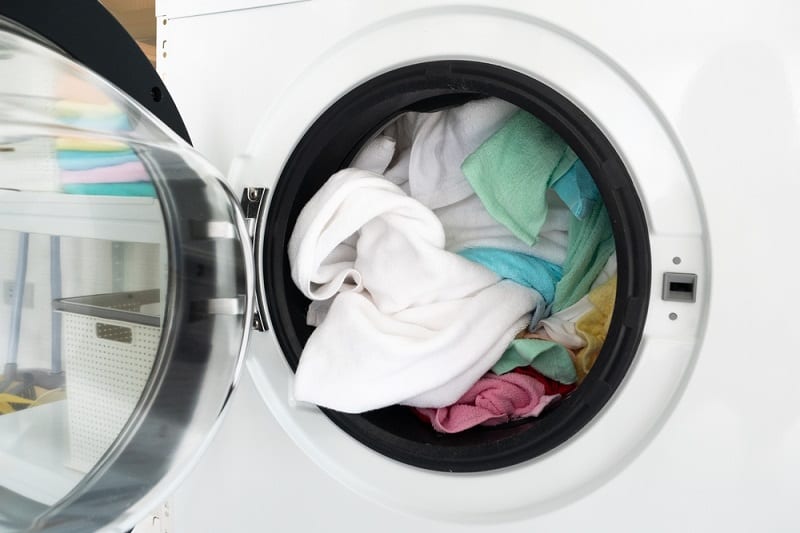Weighing laundry out every single time you plan on doing a wash isn’t exactly ideal or appealing. So, how can you figure out how much your pile of washing weighs without all the hassle of weighing each individual item?
Easy! Keep on reading to find out how much common items in your home weigh below, so you can estimate how much your washing weighs before the cleaning starts.
Laundry Weight Guide
If you’re still wondering how much your laundry weighs, then you’re in the right place. Below you’ll find a list of common items that will need washing and their average weights.
Note: Of course, do keep in mind that the average figures below will vary slightly from one house to another because we all wear different sized clothing, we prefer different materials and kids’ clothing will differ based on the age of the child.
The figures are for dry items only.
| Item | Women’s | Men’s | Children’s |
|---|---|---|---|
| Jeans | 0.5 kg | 0.7 kg | 0.2 kg |
| Cotton jumper | 0.5 kg | 0.9 kg | 0.5 kg |
| T-shirt | 0.15 kg | 0.25 kg | 0.08 kg |
| Shorts | 0.35 kg | 0.4 kg | 0.2 kg |
| Dressing gown | 6 kg | 8 kg | 3 kg |
| Smart trousers | 0.4 kg | 0.65 kg | 0.25 kg |
| A light jacket | 1.2 kg | 2 kg | 1 kg |
| A pair of socks | 0.06 kg | 0.07 kg | 0.03 kg |
| A pair of trainers | 0.6 kg | 0.9 kg | 0.4 kg |
Here are some other household items to consider. Once again, the weights of these goods may vary from one house to another because we all like different materials.
| Item | Weight |
|---|---|
| Cotton towel | 0.7 kg |
| Cotton pillow case | 0.25 kg |
| Double cotton quilt cover | 0.7 kg |
| Cotton tea towel | 0.3 kg |
| Pair of lightweight curtains (nets) | 6.5 kg |
Let’s take a look at how you could pile your laundry up.
Note: The examples below are based on the figures above, you will likely have to adjust the numbers to suit your own laundry. In addition to this, remember that these are examples, you should wash your clothes according to each clothing label.
What does 6 kg of laundry look like?
Here’s an example of what 6 kg of laundry would look like:
- 3 women’s jeans (1.5 kg)
- 3 women’s cotton jumpers (1.5 kg)
- 4 men’s t-shirts (1 kg)
- 3 men’s shorts (1.2 kg)
- 3 women’s t-shirts (0.45 kg)
= 5.6kg
What does 7 kg of laundry look like?
Here’s an example of what 7 kg of laundry would look like:
- 4 women’s jeans (2 kg)
- 2 men’s jeans (1.4 kg)
- 2 men’s cotton jumpers (1.8 kg)
- 2 men’s shorts (0.8 kg)
- 4 men’s t-shirts (1 kg)
= 7kg
What does 8kg of laundry look like?
Here’s an example of what 8 kg of laundry would look like:
- 4 children’s cotton jumpers (2 kg)
- 1 children’s dressing gown (3 kg)
- 2 children’s jeans (0.4 kg)
- 3 women’s cotton jumpers (1.5 kg)
- 2 women’s jeans (1 kg)
= 7.9kg
What does 9 kg of laundry look like?
Here’s an example of what 9 kg of laundry would look like:
- 8 men’s t-shirts (2 kg)
- 3 men’s jeans (2.1 kg)
- 2 men’s cotton jumpers (1.8 kg)
- 1 men’s light jacket (2 kg)
- 2 men’s shorts (0.8 kg)
= 8.7kg
What does 10 kg of laundry look like?
Here’s an example of what 10 kg of laundry would look like:
- 7 women’s jeans (3 kg)
- 4 women’s cotton jumpers (2 kg)
- 10 women’s t-shirts (1.5 kg)
- 4 women’s shorts (1.4 kg)
- 1 women’s light jacket (1.2 kg)
- 2 pairs of women’s smart trousers (0.8 kg)
= 9.9kg

How Do You Actually Weigh Laundry?
This is one of the simplest ways to find out how much your laundry weighs…
Stand on a scale and weigh yourself, then weigh yourself holding the pile of laundry you intend on washing.
Next, subtract your single weight from the larger figure. The number you’re left with is the weight of your pile of laundry.
Additionally, you could way out each item, jot down the figures in a book and refer to this book when you do your laundry.
This is time-consuming initially, but you’ll eventually speed up this process as you learn how much your garments weigh.
Or you could pop an item of laundry on the scale, and keep adding to the ever-growing pile until you reach your desired weight.
This option can be a little messy and doesn’t always go right – especially when the pile of dirty washing topples over.
Why Do You Need to Know How Much Laundry Weighs?
You may have been advised in the past to just ‘stick all your washing in the washing machine and let it do its thing’, and while this sounds simple enough to do, it can actually lead to quite negative consequences.
Overfilling a washing machine can put a lot of strain on the bearings, the seal and the motor. And while these issues may seem insignificant at first glance, they can be extremely problematic if they are not dealt with effectively.
Typically, the parts listed above will need to be replaced if they start to falter, and while these jobs may not be too expensive, they can be time consuming.
Further to this, if you overfill a washing machine with too many items, the laundry will not be washed correctly. This would make the whole washing cycle a little pointless because you’d have to go back and rewash the laundry.
On the flip side of this, if you don’t put enough laundry in the washing machine you run the risk of running less economical washes.
As a direct consequence you’ll waste time, money and energy. And not to mention the fact that you’ll also use up your washing products faster.
How Do You Know if the Washing Machine Is Too Full?
When packing a washing machine, you should leave enough space for your laundry to move around freely.
Your items should not be packed in so tight that they cannot move around. If items can’t move, they won’t be washed properly.
A handy trick is to check if there’s enough clearance between the top of your washing pile and the top of the drum.
If you can put your hand comfortably into this gap, then you can rest assured that your laundry has enough room to move around.

Bethan has a passion for exploring, reading, cooking and gardening! When she’s not creating culinary delights for her family, she’s concocting potions to keep her house clean!






